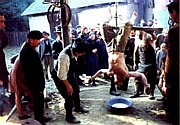 | | Martin Šulík: The grim jester? |
The Country behind the Landscape
Martin Šulík's Krajinka
Christina Manetti
Martin Šulík's films have frequently addressed the question of Slovak identity, and the place of the Slovak countryside in it; both of these themes once again figure prominently, and both of these themes seem to be at the fore in his latest work, Krajinka (2000). The film—actually not really one film, but ten short, unrelated stories—takes viewers chronologically through Slovakia's twentieth-century history, as seen from the perspective of life in small towns and villages. However, Sulik's attitude is very different from that employed in his previous films.
What's in a name?
The film has a rather ambiguous title, as krajinka is the Slovak diminutive for "country," "region," or "landscape." Although the last possibility has been used as the official translation, it is the least appropriate of the three in this case. Šulík's choice of title, however, quite clearly indicates that he intends to make some kind of statement about the national character of this rather small (about 5 million people), relatively new state of Slovakia (which achieved independence on 1 January 1993).
This is reinforced by an introduction to the film in which a narrator tells us:
This film is about a country that seemingly never existed, because no one remembers it and no one talks about it. So let us try and begin. Maybe then this little country, too, will appear on some map one day.
The stories, however, do not actually address these issues directly. Instead, they recreate the mood of that lost krajinka and do so very convincingly, with vivid details and characters. While some of the them are amusing, most are tragicomic, with the tone becoming decidedly grimmer as we approach the present.
No more happy days
Sulík told CER the stories are mostly real ones that he or screenplay co-author Dušan Dušek have heard themselves from older friends and family members— so there must be, contrary to what the film's introduction implies, at least some people who continue to tell such stories and talk about this country. [See accompanying interview]
Šulík and Dušek also explained that they set out to make a light-hearted film, something like a modern-day Slovak Decameron, to bring some smiles to what has been a rather down-in-the-mouth Slovak nation of late. As Šulík himself admitted, however, with a sad look, "it didn't come out as funny as we would have liked."
One of the more memorable stories, for example, recounts how a rather wimpy cartographer in the Austro-Hungarian army managed to rise to the amorous challenge set by a watchmaker's widow, thus "winning" a pocket watch from her. It turned out, however, that the best ones had already been taken by the rest of his regiment before him.
Another story, with a rather grotesque medieval air to it, tells the story
 | | Slovakia: a cruel place? | of one village's deaf-mute shepherd who swallows a snake while asleep in a field. No one believed the poor fellow, and they all laughed at him—until the snake came slithering out of his mouth while they had him hung upside down as a joke.
Other stories feature (anti-)heroes such as a homeless man who escapes punishment for having stolen food by diving into a cesspool; a pathetic drunken mama's boy, who nevertheless is an expert at nose-wrestling (a first for this film!); a middle-aged woman who, having emigrated from her native village to Prague long ago, comes back for a short visit to find that her life in the Big City probably has not made her any happier than her old classmate who stayed behind; and a poacher who lives an isolated life with his son in what appears to be a very desolate (and, significantly, depopulated) rural Slovakia.
Moral, immoral or amoral?
As amusing as these stories are, they are at times frustrating, since their brevity does not allow for much substantial plot or character development. Furthermore, since the film's title and narrated introduction raise the expectation that there will follow some commentary on national values, it is puzzling that little gets revealed about the "old" Slovakia that people had forgotten. Right from the film's suggestive introduction, the audience wonders what it is that has been lost: was it something good or not? and what values did it possess, if any, that Šulík is trying to resurrect here? This message, if it exists at all, is difficult—if not impossible—to discern.
It is certainly safe to say that at least Šulík did not try to expound
 | | Not looking to the past | Slovakia's historical experience as a source of moral values or national character. Although the Second World War, the wartime independent Slovak state, the Jewish question, 1968 and Normalization are all touched on in the film, they are not its focus. In fact, we are made aware of them only tangentally, principally through Šulík's use of black and white archival footage. They show, for example, the Stalinist-era desecration of churches and Soviet tanks in the streets in 1968, and are interpreted, like the rest of the film, by the rather over-talkative narrator.
Indeed, the director would like us to believe historical events do not have a direct effect on the people that live through them, at least in Slovakia. It is not these events that people most remember—even though three different armies do go marching through one man's yard in the course of the film. Instead, it is the funny, everyday events that people remember most, and pass down in the kind of the stories that Šulík and his co-author have recreated here.
Slovakia's not the answer
Thus, unlike Šulík's previous films, Krajinka does not try to convince us that Slovakia—and especially rural Slovakia—represents any sort of answer to Slovaks' current problems.
 | | Being at peace | Whereas Šulík has in the past urged a return to "simple living" in the Slovak countryside in Záhrada ( The Garden, 1995), for example, or held up the example of non-emigration from Slovakia as the key to being at peace with oneself, as in Všetko, čo mám rád ( Everything I Like, 1992), neither of these seems to be convincing enough anymore in the post-Mečiar era of economic and political troubles.
The countryside is no longer the idyllic haven that it used to be, as depicted in Záhrada—we see its shadier side this time, as well. In the end, non-emigration (to Prague) turned out to give the village-dweller only a slight psychological advantage in the face of life's hardships, which mirrored those of her city-dwelling counterpart.
As I watched Krajinka with my friend who had just arrived and was visiting Slovakia for the first time from Moscow, I began to wonder what she
would think of Slovaks after this film—essentially her first impression of the country. In it, senseless cruelty seems to be the nation's dominant character trait. (For example: children trying to set fire to the vagabond whom they'd locked into the outhouse (who was to be given a thrashing for having stolen some sausage), boys hacking off birds' wings, poachers at work, and a crowd of insensitive village-folk laughing cruelly at their deaf-and-dumb neighbor boy.
The harshest criticism in Slovakia itself, appearing in the newspaper Smer, faulted the film because it showed no positive values, only "dysfunctional" Slovak families. Although we clearly do not need an idealized picture of Slovak bliss suitable for nationalist or tourist bureau consumption, the film does clearly seem to be skewed very far toward the opposite extreme. Certainly, Šulík could have come up with more morally non-repellent visions of Slovakia from the misty recesses of his near-legendary krajinka.
But it is not so much the depiction of Slovakia has a haven of brutality that is worrying in Krajinka, but the lack of any clear, consistent message at all in this otherwise impressive film. Perhaps, though, this cannot have been avoided given the director's own undefined aims—and the rather unsettled (and, for most Slovaks, unsettling) political and economic situation in Slovakia today.
Christina Manetti, 19 February 2001
Photo credit (Šulík portrait): Slovenský filmový ústav
|
|








